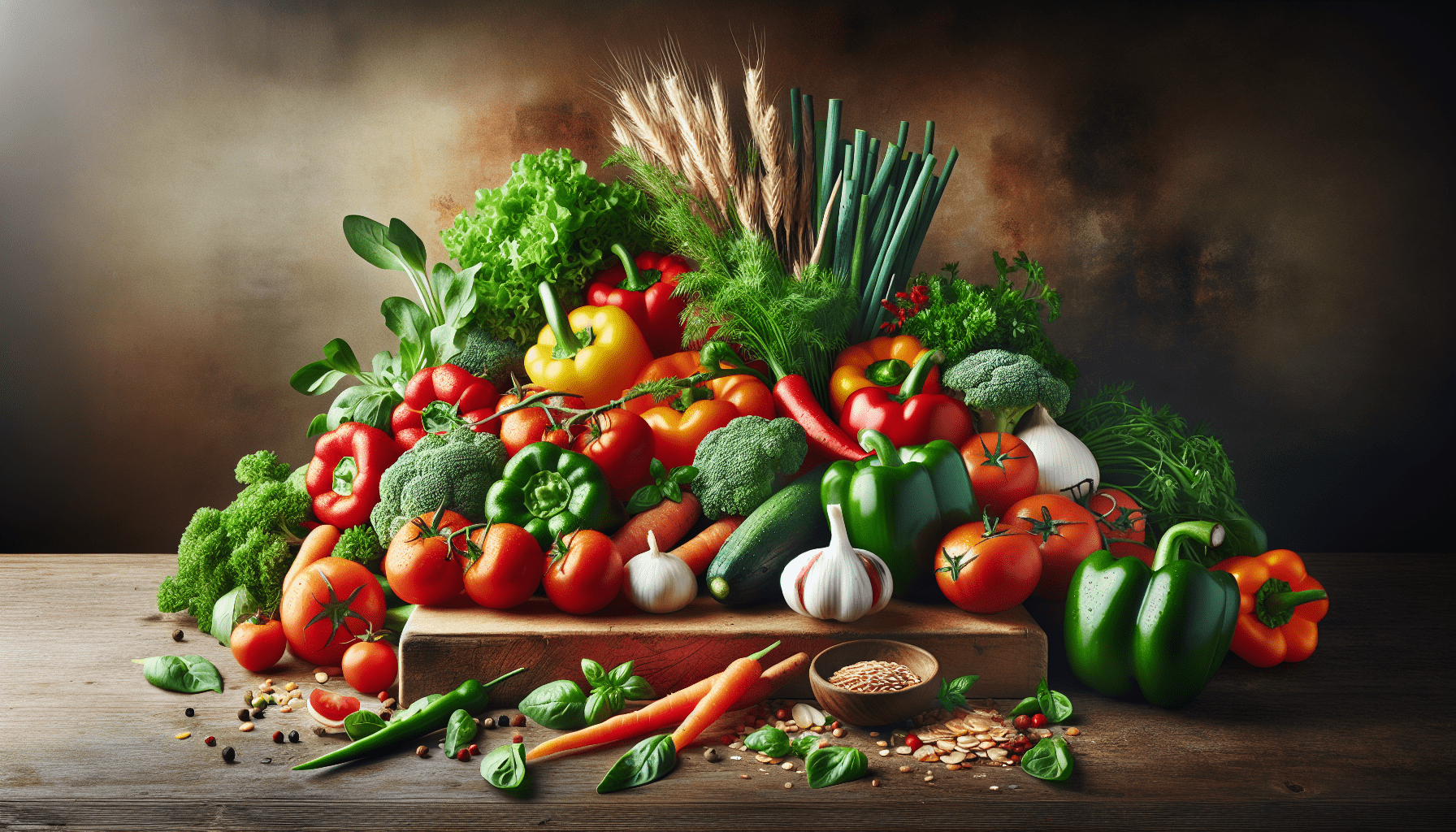In the article “Secrets of Cooking with Healthy Ingredients,” the reader is introduced to the nuanced art of using wholesome, nutrient-rich components to create flavorful and nutritious meals. The piece explores a variety of methods to seamlessly integrate healthy ingredients into everyday cooking, emphasizing the benefits of natural flavors and enhanced nutritional value. By enlightening the reader on innovative techniques and practical tips, the article aims to transform everyday dishes into vibrant culinary experiences while promoting a healthier lifestyle. Have you ever wondered how to make your meals not only delicious but also beneficial for your health? The secrets of cooking with healthy ingredients are not as elusive as one might think. Whether you are a novice in the kitchen or a seasoned chef, understanding the principles behind selecting and utilizing nutritious ingredients can transform your culinary experience. This article delves deep into the world of healthy cooking, offering insights, tips, and best practices to elevate your meals while nurturing your well-being.
Introduction to Healthy Cooking
Cooking with healthy ingredients is more than just a culinary trend; it is a lifestyle choice that promotes overall well-being. Incorporating nutritious elements into your daily cooking can lead to improved energy levels, enhanced mental clarity, and a strengthened immune system. But what exactly constitutes a “healthy ingredient”?
Defining Healthy Ingredients
Healthy ingredients refer to foods that are rich in essential nutrients such as vitamins, minerals, fiber, and antioxidants, and low in harmful elements like added sugars, saturated fats, and sodium. These ingredients support bodily functions, prevent chronic diseases, and promote overall health.
The Benefits of Cooking with Healthy Ingredients
Transforming your diet to include more wholesome ingredients has a multitude of benefits. It can help with weight management, reduce the risk of chronic diseases, improve digestive health, support mental health, and boost energy levels. Moreover, cooking from scratch allows you to control what goes into your food, reducing the intake of artificial additives and preservatives.
Core Principals of Cooking with Healthy Ingredients
Understanding the core principles of healthy cooking will enable you to make informed decisions in the kitchen. Here are some fundamental concepts to keep in mind:
Balance and Variety
A balanced diet includes a variety of foods from all food groups: fruits, vegetables, whole grains, proteins, and dairy or dairy alternatives. Each group provides essential nutrients and contributes to overall health.
Portion Control
Even healthy foods can contribute to weight gain and other health issues if consumed in excess. Learning about portion sizes and calorie intake is crucial for maintaining a healthy diet.
Cooking Methods
Certain cooking methods can preserve the nutritional value of ingredients better than others. For instance, steaming and baking are often healthier choices than frying or grilling, which can introduce harmful substances and excess fats.

Selecting High-Quality Ingredients
The quality of the ingredients you choose can significantly influence the nutritional value of your meals. Here’s how to ensure you are selecting the best possible ingredients:
Freshness
Fresh ingredients are usually more nutrient-dense than processed ones. Whenever possible, choose fresh fruits, vegetables, meats, and dairy products over their canned or processed counterparts.
Organic and Local Produce
Organic produce is grown without synthetic pesticides or fertilizers, which can reduce your exposure to potentially harmful substances. Similarly, buying locally-sourced foods can ensure freshness and support local farmers.
Reading Labels
When purchasing packaged foods, always read the ingredient list and nutrition facts. Look for products with minimal ingredients and no added sugars, artificial flavors, or preservatives.
Incorporating Fruits and Vegetables
Fruits and vegetables are cornerstones of a healthy diet. They are packed with essential vitamins, minerals, and fiber, and are naturally low in calories.
Seasonal Choices
Eating seasonal produce ensures that you are consuming fruits and vegetables at their peak nutritional value. Each season offers a variety of options, making it easier to diversify your diet.
| Season | Fruits | Vegetables |
|---|---|---|
| Spring | Strawberries, Pineapples | Asparagus, Spinach |
| Summer | Watermelon, Blueberries | Zucchini, Bell Peppers |
| Fall | Apples, Grapes | Pumpkins, Brussel Sprouts |
| Winter | Oranges, Pomegranates | Kale, Carrots |
Creative Preparation Methods
Incorporate fruits and vegetables in creative ways to make them more appealing:
- Smoothies: Blend fruits and vegetables into smoothies for a nutritious breakfast or snack.
- Salads: Use a mix of leafy greens, colorful veggies, and fruits to create vibrant salads.
- Roasting: Roasting vegetables can enhance their natural sweetness and flavor.

Including Whole Grains
Whole grains are a healthier alternative to refined grains. They retain more nutrients and fiber, which are essential for digestive health.
Types of Whole Grains
Incorporate a variety of whole grains into your diet to benefit from different nutrients:
- Quinoa: A complete protein that is also rich in fiber and minerals.
- Brown Rice: A staple food that provides complex carbohydrates and essential vitamins.
- Oats: High in beta-glucans, which can help reduce cholesterol levels.
Cooking Tips
Cook whole grains in large batches and store them for quick and easy use throughout the week. Flavor them with herbs, spices, or a splash of lemon juice to enhance taste without adding extra calories.
Choosing Lean Proteins
Protein is essential for building and repairing tissues, enzymes, and hormones. Opting for lean protein sources can help you meet your nutritional needs without consuming excess saturated fat.
Best Sources of Lean Protein
Lean protein options include both animal and plant-based sources:
- Chicken Breast: Skinless chicken breast is low in fat and high in protein.
- Fish: Fatty fish like salmon and mackerel are high in omega-3 fatty acids.
- Legumes: Beans, lentils, and chickpeas are excellent plant-based protein sources.
Cooking Methods for Lean Proteins
Grilling, baking, and steaming are healthier options for cooking lean proteins. Avoid frying, as it adds unnecessary fats and calories.

Utilizing Healthy Fats
Healthy fats are crucial for cell structure, hormone production, and nutrient absorption. Unlike unhealthy fats, they do not contribute to heart disease.
Types of Healthy Fats
Incorporate these sources of healthy fats into your diet:
- Avocado: Rich in monounsaturated fats and versatile in use.
- Nuts and Seeds: Provide essential fatty acids and protein.
- Olive Oil: A staple of the Mediterranean diet, known for its heart-healthy properties.
Cooking with Healthy Fats
Use healthy fats in moderation. Drizzle olive oil on salads, use avocado as a spread, and include nuts and seeds in your meals for added texture and flavor.
Reducing Salt and Sugar Intake
Excess salt and sugar can contribute to health issues like hypertension, diabetes, and weight gain.
Alternatives to Salt
Use herbs, spices, and other seasonings to enhance the flavor of your dishes without adding salt. Experiment with garlic, basil, cumin, and lemon juice.
Alternatives to Sugar
Natural sweeteners like honey, maple syrup, and stevia can be used sparingly instead of refined sugar. Additionally, fruits can add natural sweetness to dishes.

Hydration and Cooking with Liquids
Water is essential for life and plays a critical role in cooking. Proper hydration helps with digestion, nutrient absorption, and temperature regulation.
Types of Healthy Cooking Liquids
Opt for these healthier cooking liquids:
- Water: The most essential and versatile cooking liquid.
- Broth: Homemade vegetable or bone broth adds flavor and nutrients.
- Coconut Water: A natural hydrator that can be used in smoothies and soups.
Planning and Preparing Meals
Effective meal planning and preparation can help you make healthier food choices and save time during the week.
Meal Planning Tips
- Plan Ahead: Design a weekly meal plan and incorporate a variety of healthy ingredients.
- Keep it Simple: Start with simple recipes and gradually experiment with more complex dishes.
- Batch Cooking: Prepare large quantities of food at once and portion out meals for the week.
Grocery Shopping Strategies
- Make a List: Plan your grocery list based on your meal plan to avoid impulse buys.
- Shop the Perimeter: Focus on the outer aisles of the store where fresh produce, meats, and dairy are located.
- Read Labels: Avoid processed foods and snacks by reading labels and selecting products with minimal ingredients.

The Importance of Mindful Eating
Mindful eating involves paying full attention to the experience of eating and enjoying your food without distractions. This practice can improve your relationship with food and aid digestion.
Techniques for Mindful Eating
- Eat Slowly: Chew your food thoroughly and savor each bite.
- Listen to Your Body: Eat when you are hungry and stop when you are full.
- Remove Distractions: Turn off the TV and put away your phone while eating.
Benefits of Mindful Eating
Mindful eating can lead to better digestion, reduced overeating, and a greater appreciation for food. It fosters a healthier relationship with eating and can contribute to overall well-being.
Conclusion
Cooking with healthy ingredients is a powerful way to enhance both the flavor and nutritional value of your meals. By incorporating fresh, nutrient-dense foods and adopting healthier cooking methods, you can create delicious dishes that support your health and well-being. Remember, the secrets of cooking with healthy ingredients lie in understanding balance, variety, and mindful preparation.
By following the guidelines and tips provided in this article, anyone can transform their kitchen into a haven of healthy, delicious food. Whether you are preparing a simple salad or a gourmet meal, the key is to make informed, conscious choices that prioritize your health and enjoyment. Happy cooking!









